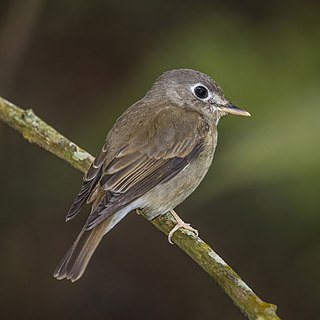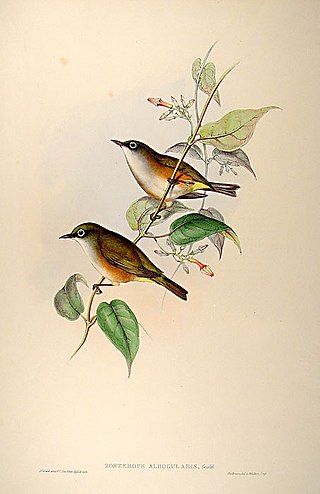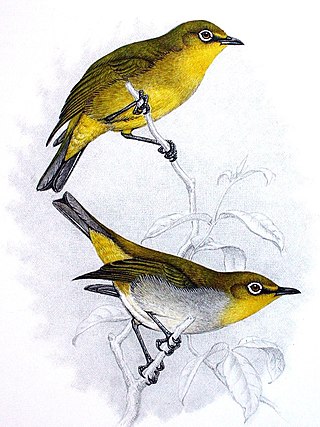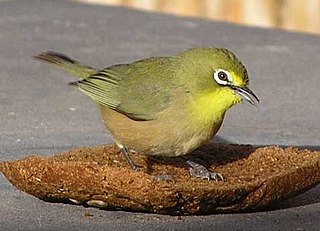
Zosterops is a genus of passerine birds containing the typical white-eyes in the white-eye family Zosteropidae. The genus has the largest number of species in the white-eye family. They occur in the Afrotropical, Indomalayan, and Australasian realms. Typical white-eyes have a length of between 8 and 15 cm. Their most characteristic feature is a conspicuous white feather ring around the eye, though some species lack it. The species in this group vary in the structural adaptations of the tongue. The Zosterops [griseotinctus] group is an example of a "great speciator" inhabiting a vast area and showing a remarkable morphological differentiation on islands, some of which maybe as close as 2 km (1.2 mi) apart.

The white-eyes are a family, Zosteropidae, of small passerine birds native to tropical, subtropical and temperate Sub-Saharan Africa, southern and eastern Asia, and Australasia. White-eyes inhabit most tropical islands in the Indian Ocean, the western Pacific Ocean, and the Gulf of Guinea. Discounting some widespread members of the genus Zosterops, most species are endemic to single islands or archipelagos. The silvereye, Zosterops lateralis, naturally colonised New Zealand, where it is known as the "wax-eye" or tauhou ("stranger"), from 1855. The silvereye has also been introduced to the Society Islands in French Polynesia, while the Japanese white-eye has been introduced to Hawaii.

The Indian white-eye, formerly the Oriental white-eye, is a small passerine bird in the white-eye family. It is a resident breeder in open woodland on the Indian subcontinent. They forage in small groups, feeding on nectar and small insects. They are easily identified by the distinctive white eye-ring and overall yellowish upperparts. The range previously extended eastwards to Southeast Asia, Indonesia and Malaysia. Their name was recently changed due to previous members of Zosterops palpebrosus in Southeast Asia being renamed to a new species, making the Indian White-eye a more geographically accurate term for this species.

The sirkeer malkoha or sirkeer cuckoo, is a non-parasitic cuckoo found in dry scrub forest and open woodland habitats in the Indian subcontinent. The species is long-tailed, largely olive brown on the upper side with a distinctive curved red beak tipped in yellow. They forage singly or in pairs mainly on or close to the ground creeping between grasses and bushes, often on rocky habitats where they feed on small lizards, insects, and sometimes berries and seeds. They are very silent and the sexes are identical in plumage.

The Sri Lanka hill myna, Ceylon myna or Sri Lanka myna, is a myna, a member of the starling family. This bird is endemic to Sri Lanka.

The white-tailed trogon is a near passerine bird in the trogon family. It is found in tropical humid forests of the Chocó, ranging from Panama, through western Colombia, to western Ecuador. It was formerly considered a subspecies of T. viridis, which is widespread in South America east of the Andes, but under the English name white-tailed trogon.

The brown-breasted flycatcher or Layard's flycatcher is a small passerine bird in the flycatcher family Muscicapidae. The species breeds in north eastern India, central and Southern China and northern Burma and Thailand, and migrates to southern India and Sri Lanka. It forages for insects below the forest canopy, often close to the forest floor.

The white-chested white-eye also known as white-breasted white-eye or Norfolk white-eye is a passerine from the family Zosteropidae. It is endemic to Norfolk Island between New Caledonia and New Zealand and it is regarded as either extremely rare or possibly extinct. Since 2000 the Australian government has considered the species extinct.

The Cape white-eye is a small passerine bird in the white-eye family. It is native to southern Africa. It is commonly found in suburbia, parks and gardens, besides a variety of mesic to well-watered habitats.

The Abyssinian white-eye or white-breasted white-eye is a small passerine bird belonging to the genus Zosterops in the white-eye family Zosteropidae. It is native to north-east Africa and southern Arabia.

The Vanuatu white-eye or yellow-fronted white-eye is a small passerine bird belonging to the genus Zosterops in the white-eye family Zosteropidae. It is endemic to Vanuatu, where it is one of the most common birds.

The pale-bellied white-eye is a species of bird in the family Zosteropidae. It is endemic to SE Sulawesi in Indonesia. Its natural habitat is subtropical or tropical moist lowland forest. The species has a limited distribution and also appears to be sensitive to human disturbance.

Heuglin's white-eye, also known as the Ethiopian white-eye, is a species of bird in the family Zosteropidae. It is found in north-eastern and eastern Africa, primarily in Ethiopia and Kenya. Its natural habitats range from subtropical or tropical moist montane forests, to subtropical or tropical high-altitude shrubland, plantations, and rural gardens.

The green-backed white-eye is a species of bird in the family Zosteropidae. It is also known as the New Caledonian white-eye. It is endemic to New Caledonia.
The Seram white-eye is a small passerine bird in the white-eye family. It is an endemic resident breeder in open woodland in Seram, Indonesia.

The Orange River white-eye is a species of bird in the family Zosteropidae, which is native to Namibia and South Africa. It was formerly deemed conspecific with the Cape white-eye, but the two species occur sympatrically in central South Africa, and they are genetically distinct.

Kaludiya Pokuna Archeological Forest Site, is a forest with archeological remains in Kandalama, in the Dry Zone of Sri Lanka. The site has been handed over to the Girls' High School, Kandy in accordance with the "Urumaya Thani Nokaramu" program organized by the Department of Archeology. For the first time in Sri Lanka, a school was given custody of an archeological site.

















